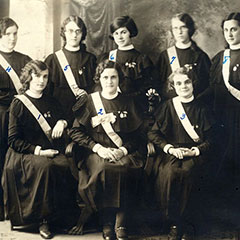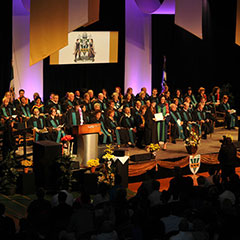Commencement Ceremonies
One of life’s fundamental steps is, of course, the end of one’s studies. Rituals that are associated with this rite of passage have evolved and become more refined according to time and trends. Receiving an academic degree takes on special importance in that it symbolises self-fulfilment as well as the acknowledgment of peers and faculty. Different ceremonies involve strict decorum including ritual objects such as the cap and gown, the red carpet, procession and official photo shoot.
Traditionally, in Québec, one’s school journey ended at the age of 14 or 15. Prizes were given out at the end of the year and diplomas were handed out to the most deserving students at the end of the elementary course, under the auspice of the teacher, a priest, and a member of the school board. In the 1950s, for higher grades, a classical education was crowned by a ceremony called “taking of ribbons”. The color of the ribbon worn for the ritual indicated the graduate’s field of study: purple for priesthood, red for medicine, blue for law and yellow for science.
Even today in Québec, graduation ceremonies mark the end of an educational journey. Gown, mortar boards and ribbons are still part of the graduation ceremony protocol. In most leading universities, officials in the procession are distinguished by graduation ribbons different from those of the graduating students. Similarly, university undergraduate students do not wear the same distinctions on their shoulders as postgraduate students do.
Pomp and Circumstance
Pomp and Circumstance is a series of five military marches to be played by an orchestra, composed by Englishman Edward Elgar (1857-1934). The piece’s title comes from Othello’s speech in Act 3 of William Shakespeare’s play. It was however the first march of the series (March No. 1) that made an impression: at its first public performance, it garnered two curtain calls.
The melody of March No. 1, a combination of nostalgia and pride, is well suited to graduation ceremonies. It was used for this purpose for the first time on June 28th 1905 at Yale University at the suggestion of Samuel Sanford, music professor and a friend of Edward Elgar’s. Around the middle of the 1920’s, the piece became a musical staple of university commencement ceremonies. Nowadays, playing Pomp and Circumstance's March No. 1 is as closely associated to graduation as the cap and gown are.
Pomp and Circumstance, Op. 39, March No. 1 in D Major
Download audio (1 minute 53 seconds, 1.73 MB)
Trio of the March No. 1, extract of Pomp and Circumstance, Op. 39, played by an orchestra. The Trio section of March No. 1, directed by Sir Edward Elgar on the opening of EMI's Abbey Road Studios on November 12, 1931.
Composer: Edward Elgar,1901
Source: Wikipedia





